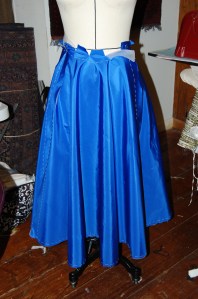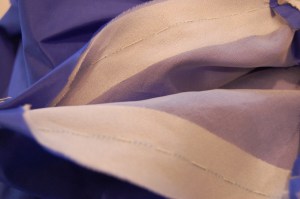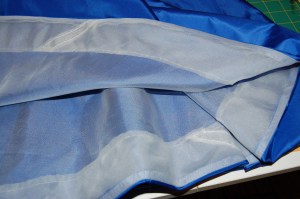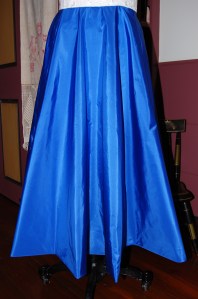Whoever knew there could be so many valuable tips to be learned about sewing with taffeta? The second “part” of my dress, which I began under the tutelage of Susan Khalje in early June, was simple compared with the embroidered silk organza overlaid bodice. However, it proved to be an excellent opportunity to learn about some of the peculiarities inherent in silk taffeta.
The skirt pattern for which I had made a muslin (toile) in preparation for class was actually a full circle with 4 seams. I wasn’t so sure I wanted anything quite so full, and as I only had 3½ yards of 35” wide taffeta, I also wasn’t so sure I had enough fabric to make such a skirt. But what really put the kibosh to those plans was Susan’s observation that silk taffeta does not perform well with seams cut on the straight of grain (seams sewn thus, apparently do not lie flat and drape well.) She suggested a three-part skirt, with one panel centered on the front, and the other two joined to the sides of that front panel and then seamed together up the back. All cut edges would be on the bias, with the straight of grain being down the center of each panel. So we took one prepared muslin piece and made these changes to it:
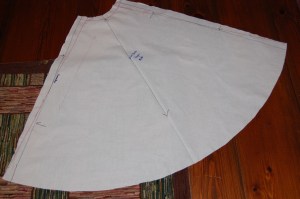
This is one of the original 4 panels. We redrew the side seams, adding enough to the waist to compensate for reducing the skirt to three panels, and by doing that, also reduced the width at the bottom of the panel.
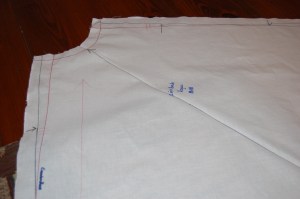
Here is a close-up, with the new side seam lines and straight of grain going up the middle rather than down the side. Both are marked in black.
Once I had my new pattern piece, cutting it out was easy and took every inch of the sapphire blue taffeta I had brought with me. Here is what it looked like when the seams were stitched:
The next surprise I had was about the silk organza underlining. I am so used to catch-stitching seams to organza underlining in couture sewing. But with taffeta, it’s better not to do so. With the impressionable finish of taffeta, such catch-stitching could “shadow” on the front of the garment. So I left the seams unsecured on the wrong side:
Ironing those seams also took special attention. Susan had me iron them over a seamroll, taking care to “spread” the seam so that the tight stitching actually would show in front of the point of the iron. This was to get a crisp seam. Once ironed, taffeta does not respond well to changes in your intent (like some people we all know), so it has to be done correctly the first time.
Because the center back zipper would be applied onto the bias, Susan had me use a little fusible interfacing to reinforce that seam. Luckily, Becky, a classmate, had a bag of all kinds of high quality fusible interfacings with her! (Thanks, Becky!)
I certainly did not get to the hem of the skirt before I left for home, but Susan gave me tips on how to sew that wide and curved expanse. I cut a 2½” strip of silk organza to use as a hem facing. I turned it up with a very narrow strip of blue taffeta exposed on the wrong side. Then I used a very short straight stitch to secure the organza facing to the organza underlining:
I haven’t pressed the hem yet, but Susan has instructed me not to press the edge of the hem flat. It should have a little softness to it, which is the French way! I’m all for that.
The lining, which will be the full expanse of the skirt itself, will be out of silk crepe de chine and will hang loose.
In the past, I have always thought of taffeta as kind of stiff and a little too structured for my taste, but now I am a fan. I like the slight rustle to it, and when constructed properly, it drapes and moves beautifully. The secret is to work with very fine quality silk taffeta – and know the tricks! Thanks, Susan!

